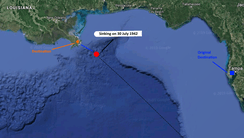SS Robert E. Lee (1924)
SS Robert E. Lee was a steam passenger ship built for the Eastern Steamship Lines in 1924.[1] It was sunk on 30 July 1942 after being torpedoed by the German submarine U-166 on its return to New Orleans.[2]
| History | |
|---|---|
| United States | |
| Name: | Robert E. Lee |
| Operator: | Eastern Steamship Lines |
| Builder: | Newport News Shipbuilding |
| Completed: | 1924 |
| Fate: | Torpedoed by U-166 on 30 July 1942 |
| General characteristics | |
| Type: | Passenger ship |
| Tonnage: | 5,184 |
| Length: | 373 ft (114 m) |
| Beam: | 54 ft (16 m) |
| Depth: | 29 ft (8.8 m) |
Construction
SS Robert E. Lee was built in Newport News, Virginia and finished construction in 1924. The ship had a keel length of 375 feet (114 m), a beam length of 54 feet (16 m) and a depth of 29 feet (8.8 m). The ship was constructed to primarily transport passengers between Virginia and New York.[1]
History

.jpg)
In February 1942 Robert E. Lee was chartered by the Alcoa Steamship Company to transport goods and personnel from New York to ports located in the Caribbean. One month later, in March 1942 she was contracted by the War Shipping Administration as a freight carrier and was subsequently armed with a stern gun and degaussed to prevent magnetic mine attacks.[1]
Sinking
On 30 July 1942, Robert E. Lee left Trinidad with around 270 passengers bound for Tampa, Florida. She initially traveled with convoy TAW-7 but was soon diverted to New Orleans along with the submarine chaser USS PC-566.[3]
At 22:37 a single torpedo was fired at the ship by U-166. The torpedo was spotted by lookouts 200 yards (180 m) away but no evasive action was able to be taken.[4] The torpedo struck just aft of the engine room and destroyed the #3 hold. Further damage was also done to the radio compartment and the steering gear.[2]
The ship began to list to port and then starboard before finally sinking by the stern approximately 15 minutes after the torpedo hit.[5] Of the 407 crewmen and passengers, 15 passengers and 10 crewmen died in the sinking.[5][6] The survivors were rescued by the patrol boats USS PC-566, USS SC-19, and the tug Underwriter, and they were transported without incident to Venice, Louisiana.[2]
Wreckage
In 1986 an oil and gas survey conducted by Shell Offshore discovered the shipwreck of Robert E. Lee in the Mississippi Canyon. It was located at a depth of 4,700 feet (1,400 m). In January 2001 the wreckage was once again spotted, but this time it was located by C & C Technologies.[1][7] Located one mile (1.6 km) away was the wreckage of German submarine U-166 after it had been sunk with depth charges by PC-566.[8]
References
- "Robert E. Lee (1942)". HamdanLab. 2016-01-08. Retrieved 2019-11-19.
- "Robert E. Lee (American Steam passenger ship) - Ships hit by German U-boats during WWII - uboat.net". uboat.net. Retrieved 2019-11-19.
- "SS Robert E. Lee". Shipwreck World. 2016-12-01. Retrieved 2019-11-19.
- Alex, Heather; er (2014-07-14). "Gulf camera reveals site of WWII sinking of SS Robert E. Lee, German U-boat". Houston Chronicle. Retrieved 2019-11-19.
- "The Boat That Sank / The Robert E Lee and World War Two | TRIPS INTO HISTORY". Retrieved 2019-11-19.
- By Carter Maguire, Special to. "World War II wreckage haunts Gulf of Mexico". CNN. Retrieved 2019-11-19.
- "World War II Shipwrecks | Bureau of Safety and Environmental Enforcement". www.bsee.gov. Retrieved 2019-11-19.
- Lattens, Jan (2014-08-01). "SS Robert E. Lee (+1942)". WreckSite.